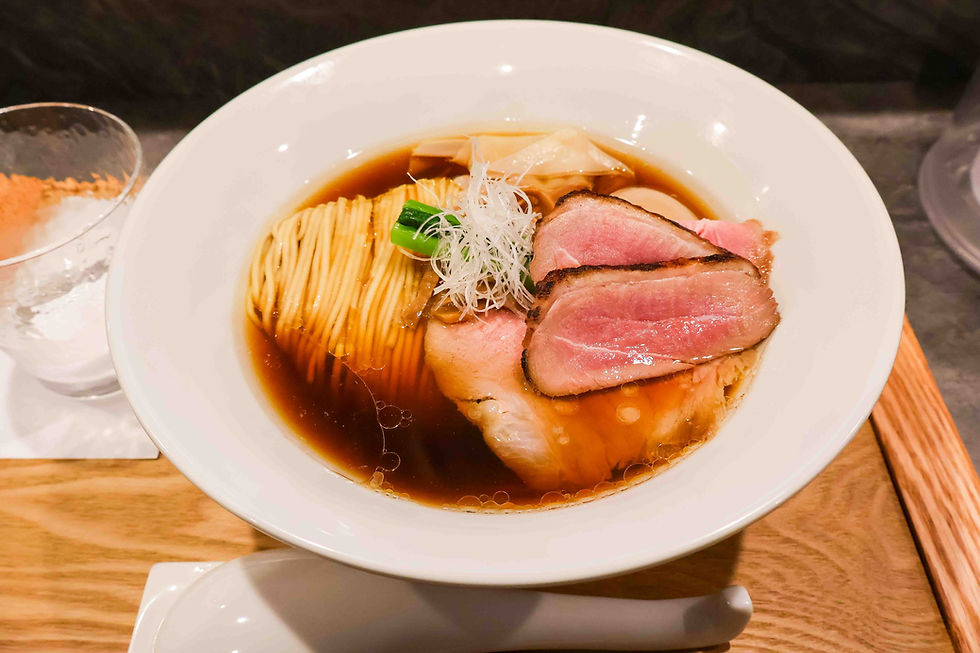Kissui Hananoren - Michelin Bib Gourmand Ramen
- Frank
- Apr 23, 2022
- 2 min read
Updated: Feb 6, 2023
Kissui Hananoren (生粋 花のれん) serves chemical free, carefully prepared ramen with ingredients from all over Japan. They’ve even got a big nod from Michelin.
Kissui Hananoren - Ramen Choices
Located in Tokyo’s Otsuka neighborhood, Kissui Hananoren is a little ramen shop with both table and counter seating.

Choose from shoyu (soy sauce) or shio (salt) ramen, tantanmen (a spicy ramen style), or a seasonal ramen. At the time I visited, the seasonal ramen was a soupless shoyu.

Each ramen impressively showcase ingredients from all corners of Japan. I was almost tempted to use bullet points when listing all the ingredients. It's a long list...
Shoyu Ramen - When in Tokyo
The base in this ramen is a blend of several (shoyu) soy sauces. Two are from Kagawa. One is dark and one is saishikomi (double fermented). The third shoyu, from Gunma, is also saishikomi. They also use nama (non-treated) shoyu from Ibaraki.

All together, these soy sauces make for a tangy and fairly sweet foundation. This foundation holds up a chicken-grounded soup. The chicken breeds in this soup are Hinai from Akita, Shamrock from Aomori, and Okukuji gamefowl from Ibaraki.

With every sip of soup, it’s crystal clear that chicken is the centerpiece. As to the noodles, they're medium-thick and are made from three types of wheat flour from Hokkaido. They use kansui (alkaline mineral water) from Mongolia when preparing them.
In the same manner, even the cooking water is special - π and ACM π water.
Shio Ramen - My Favorite
Just like in the shoyu ramen, there’s a certain purity with the flavors in the shio (salt) ramen. Not using any chemical seasoning ensures this. Instead of soy sauce, they put to work five types of salt from Okinawa.

But that’s not all - they add three types of shiro shoyu (white soy sauce) to the mix. The golden colored soup has flavor as bright as the sun. The chicken flavors are accentuated, with the soup arguably achieving new heights.

They constantly adjust the burner temperature throughout the cooking process. All of this attention to detail caught the attention of Michelin. This resulted in Kissui Hananoren being listed in the Michelin Bib Gourmand Guide for Tokyo.
Toppings Tapestry
Lastly, let's examine the toppings in both bowls. The extra crunchy menma (bamboo shoots) are from Fukuoka. The eggs they use are from Tochigi. They season them with the same soy sauces, but add some fish flavoring too.

There are two types of negi (spring onions) - Kyoto kujo and Edo Senju. The pork slices from Chiba are pork loin and belly. Soft as silk and marinated in various herbs, they're the definition of "guilty pleasure".
Lastly, we can't forget the yellow flower petals. For reference, "Hana" means flower. "Noren" refers to the curtain at the entrance of a ramen shop.
A Summary
It's almost exhausting to list (and translate) all these ingredients.

Whether you feel that they went unnecessarily far in their ingredient sourcing or not, Kissui Hananoren is certainly not monkeying around.








